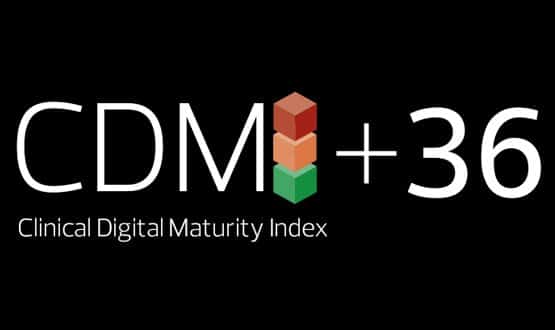NHS hospitals won’t be paperless before 2027
- 25 April 2017

A new report from Digital Health Intelligence concludes that the government’s target for all NHS hospitals to become paperless will not be met before 2027.
Digital Health Intelligence, sister company to Digital Health News, has today launched its CDMI+36 NHS technology adoption report, which has found that health secretary Jeremy Hunt’s NHS ‘Paperless 2020’ target will definitely not be met by English acute trusts.
Based on census-level data of technology adoption by all English NHS hospitals, the report projects that all NHS hospitals will not be paperless until 2027 at the earliest, a decade away.
The independent research report tracks progress against Digital Health Intelligence’s Clinical Digital Maturity Index (CDMI) NHS digital benchmark, analysing year-on-year adoption of 27 key categories of clinical IT systems by all NHS hospital trusts since 2013.
While significant progress has been made in the uptake of some systems, the adoption of some the most complex clinical systems – including electronic clinical decision support and advanced e-prescribing, which have the greatest potential to improve patient safety by cutting prescribing errors – remains slow.
The report identifies reasons for the slow progress as repeated delays and shortfalls in national NHS IT funding, together with the ageing IT infrastructure still in place across many trusts, which prohibits the adoption of more advanced paperless systems.
In 2013 Jeremy Hunt first set the objective for the NHS to become paperless by 2018, a target later extended to 2020.
In September 2016, the review of NHS IT by Dr Robert Wachter said paperless by 2018 would not be possible and suggested 2023 be set as a more realistic target.
Digital Health Intelligence’s report predicts that more cautious estimate is sensible, with the 2023 timeline likely to be met for systems such as clinical noting, document management and observations vital signs.
But by tracking over 36 months the adoption levels of e-prescribing, a key cornerstone of a paperless NHS, Digital Health has projected that a fully paper free NHS will not be achieved until at least 2027.
Tara Athanasiou, director of intelligence at Digital Health, said: “This is the first time that the census-level data of actual clinical system implementation by every NHS organisation has been used to objectively predict when the NHS will become truly paper free.
“This objective view is based only on empirical data, has proved extremely reliable and led to CDMI being used to inform tech fund awards, digital maturity assessments and global digital exemplar selections.”
The report has found that NHS acute trusts have made significant progress on digital maturity in the last 36 months, since Digital Health’s CDMI was launched. The average CDMI score has moved from 66 points out of a possible 95 in 2013 to 74 points out of 95 in 2016.
In November 2016, there were two trusts with a maximum CDMI score of 95: West Suffolk NHS Foundation Trust and Liverpool Heart and Chest Hospital NHS Foundation Trust. West Suffolk is one of NHS England’s 20 global digital exemplars, earmarked for a share of an estimated £100 million of still-awaited central funding.
The biggest improvements have been seen in five trusts that have moved from the bottom quartile of digital maturity in November 2013 to the top quartile in November 2016. These trusts are: The Walton Centre NHS Foundation Trust, Royal Brompton & Harefield NHS Foundation Trust, Northern Lincolnshire and Goole NHS Foundation Trust, University Hospitals Bristol NHS Foundation Trust, and Royal Cornwall Hospitals NHS Trust.
Some 19 of the trusts that were in the lowest quartile of CDMI in 2013 were still there in November 2016, while 18 trusts moved from the lowest quartile to a higher quartile by 2016.
The longitudinal analysis of NHS digital maturity enabled by CDMI highlights that trusts without the benefits of size and access to national funds can and have made significant advancements in terms of digital maturity.
The highest growth in adoption over the last three years has been seen in e-prescribing, document management, clinical noting, and observations vital signs.
These specific areas all benefitted from central funding through successive technology funds. The 2013 Safer Hospitals, Safer Wards tech fund provided a total of £44 million funding between 52 e-prescribing projects. The focus was diluted in later tech fund rounds, with just two e-prescribing projects funded by the 2014 Integrated Digital Care Record fund.
Despite the growth seen in these technology segments, by 2016 58% of trusts still did not have an advanced e-prescribing system, 45% of trusts did not have an observations vital signs system and 42% of trusts did not have a clinical noting system.
Athanasiou added: “Our projections are based on broadly similar levels of funding continuing to be made available for NHS IT investments by the centre. The trajectory could still change if there were significant increases or reductions in investment, large scale trust mergers or disruptive new suppliers entered the market.”
The full CDMI+36 service is available for download through the Digital Health Intelligence subscription service or to purchase as a standalone report.
Copies have been shared with leaders of the CCIO and Health CIO Networks, NHS Digital and NHS England.




3 Comments
In my opinion, we shouldn’t be aiming at a paperless NHS. A paperless NHS will be the outcome. i.e. if we use clinical IT to support clinicians in what they do, then what they’ve done is captured digitally. By having ‘paperless’ as an objective results in initiatives to scan paper which is not what we want. It is PART of what we want but improving clinical care by using clever IT is what we need.
At a time when sales of traditional books are rising and e-book sails are tailing off; and when both Trump and Putin are reported to be reverting to paper messages because of security issues, when will those with budgets realise that Electronic Data recording is complementary to Paper Records – not a replacement. A Paperless NHS will not be achievable until everywhere where any patient care takes place even by friends and family has compatible IT systems and constant reliable internet access and when a robot created by Microsoft can have an intelligent conversation with a robot independently created by Google. (=The Turing level two test)
Unusual use of the word “disruptive”. The report would appear to be based on data which is a good thing as I now tend to trust data more than I do words. In large businesses, it’s now recognized that the management of data is now as important as the management of the finances. Cong rats to all the five trusts who have made the most significant progress.
Comments are closed.